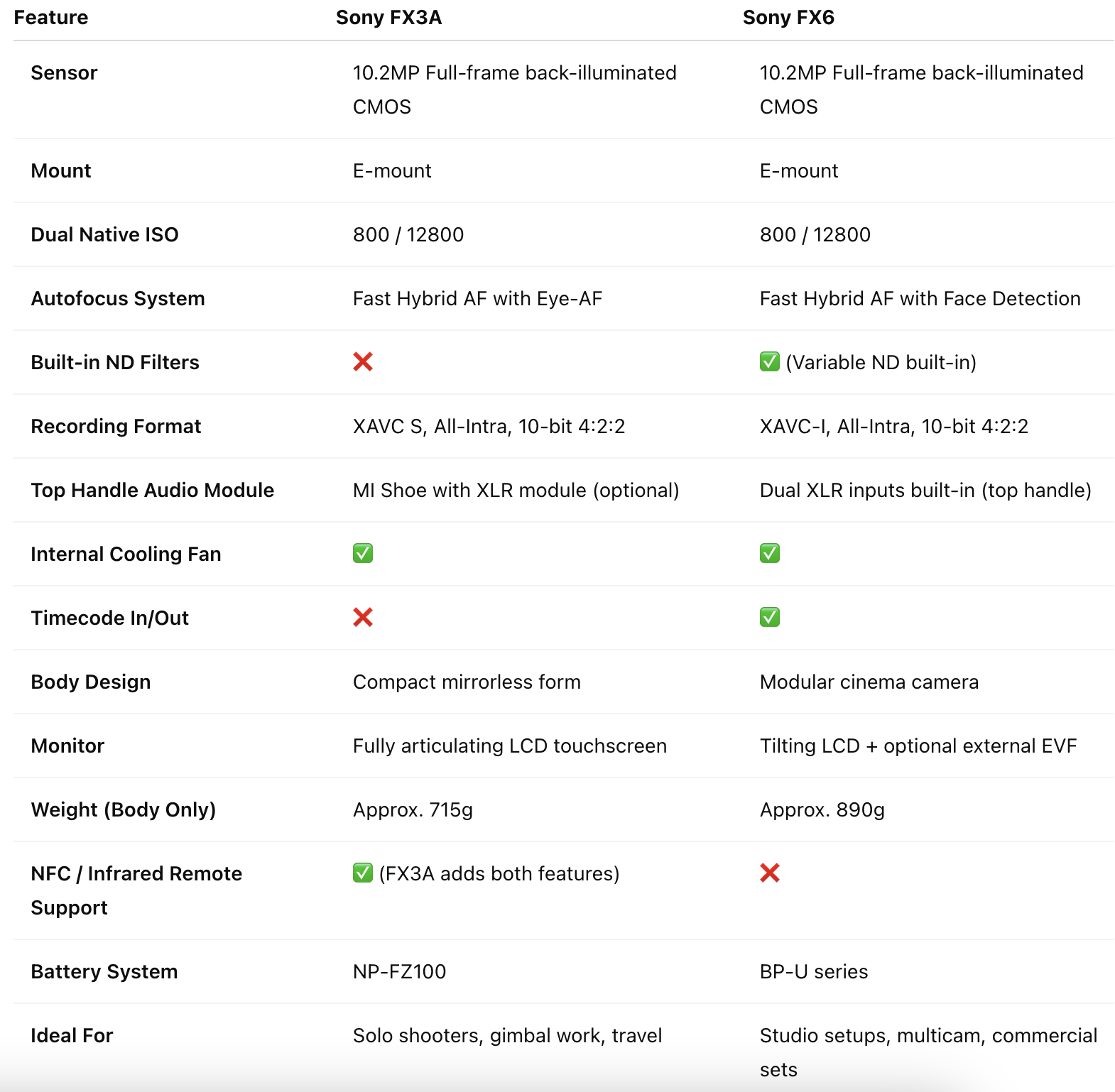Sony FX3A vs FX6: A Detailed Comparison
As Sony continues to expand its Cinema Line offerings, two models often up for comparison are the Sony FX3A and the Sony FX6. Both cameras offer full-frame sensors, cinematic color science, and impressive low-light capabilities—but they serve slightly different types of shooters. In this blog, we break down the key differences between the FX3A and the FX6 to help you understand how they stack up.
Whether you're a solo filmmaker, commercial DP, or corporate video producer, knowing the gear you're investing in matters. Here's what you need to know:
Side-by-Side Comparison
Before I continue…
Hey! If you’re looking to purchase either of these cameras once you get to the bottom of this blog, I’m just going to go ahead and say it - we’re a small business and would be so stoked if you could purchase your gear through our affiliate links. I know you’re not here for a sales pitch so I’ll keep it short. If by fueling your passion or gear list for your company you want to help ours here is the link for the FX6 and the FX3a ! Thank you so much for being here!
FX3A: The Compact Workhorse
The FX3A is a refined version of the original FX3, with updates like NFC functionality and infrared remote support that make it even more appealing for solo shooters and content creators. Its compact mirrorless-style body makes it ideal for handheld setups, gimbal work, or travel-heavy projects.
No built-in ND filter, but smaller size makes it easier to rig external ones.
More affordable than the FX6 by a significant margin.
Still image support makes it more versatile for hybrid creators.
The FX3A is a go-to for small production teams, corporate content creators, and wedding filmmakers who value flexibility, size, and affordability.
FX6: Built for Bigger Sets
The FX6 is built more like a traditional cinema camera. With variable ND filters, full-size XLRs, dedicated timecode, and a more modular design, it's perfect for crews that need pro-level features out of the box.
Better onboard audio and I/O capabilities.
Built to integrate seamlessly into larger production workflows.
Slightly larger, but easier to balance on bigger rigs and tripods.
If you're working on narrative, branded content, or multi-cam setups, the FX6 might be worth the higher price tag.
Final Thoughts
The FX3A and FX6 are both stellar cameras with overlapping features, but they serve different filmmakers. If you're a solo shooter or working on lean budgets, the FX3A is a powerhouse in a compact form. If you're part of a larger team or need a camera that can do it all on a pro set, the FX6 still reigns supreme.
No matter which one you choose, you're getting Sony's top-tier full-frame performance and cinematic quality.
Looking for Boston-based video production using cameras like the FX3A or FX6? Get in touch with Bunker Hill Media to start your next project with the right tools and the right team.
-
The FX3A and FX6 share many core features, like a full-frame sensor and 4K 120fps capabilities, but differ significantly in body style and professional features. The FX6 includes built-in variable ND filters, dual full-size XLR inputs, timecode support, and a more modular, cinema-style design. The FX3A is more compact, lacks internal ND filters, and is better suited for solo shooters or lightweight setups.
-
Yes, the FX3A’s lightweight body and mirrorless-style design make it ideal for run-and-gun setups, gimbal use, or travel filming. Its flip-out touchscreen and compact build are perfect for solo creators. However, if you need more advanced audio and monitoring options, the FX6 may be a better fit.
-
Filmmakers working on larger sets or commercial productions might prefer the FX6 for its robust professional features like internal ND filters, timecode sync, and dual XLR audio inputs. It’s also designed for modular rigging, which suits more complex setups. The FX6 gives you more control in fast-paced or multi-camera shoots.

